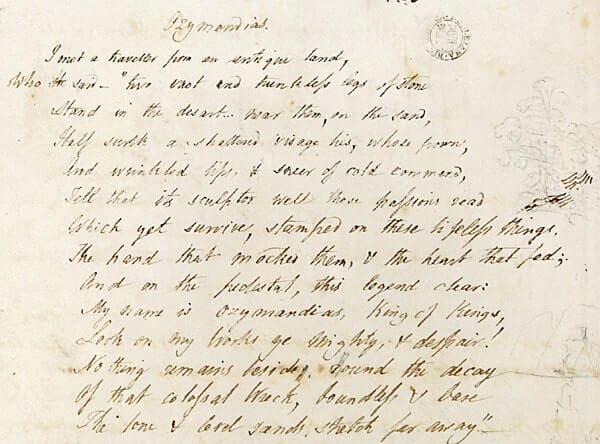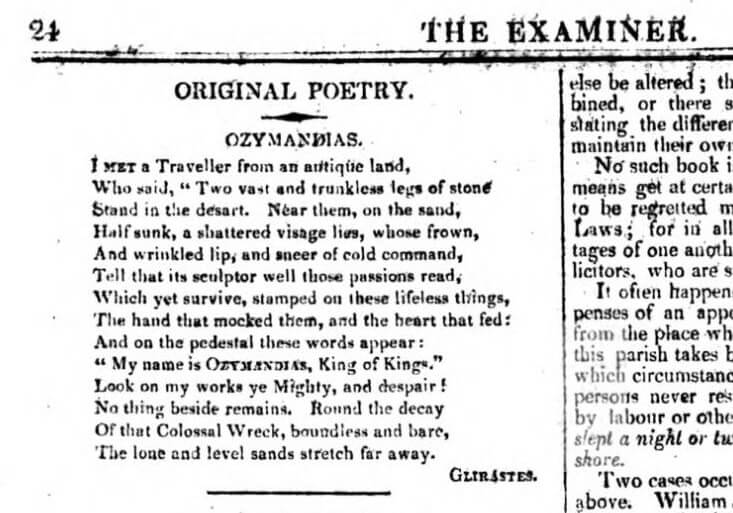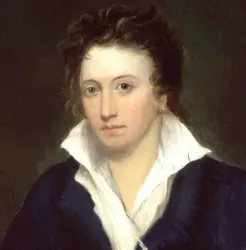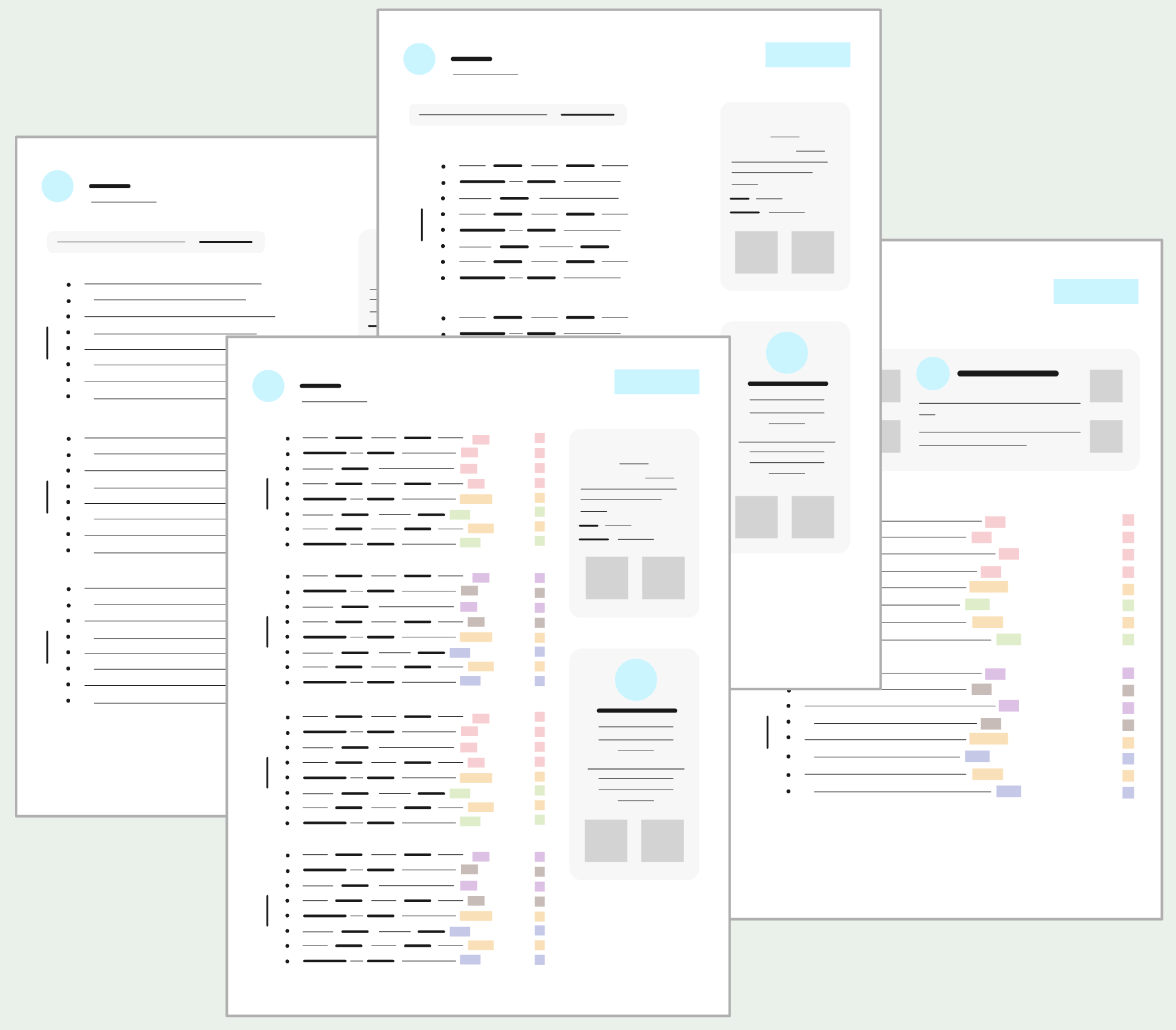‘Ozymandias’ is written by one of the greatest 19th-century British poets, Percy Bysshe Shelley. It was first published in 1818 in The Examiner of London under Shelley’s pen name, “Gilrastes.” In this sonnet, Shelley’s speaker encounters a traveler from an antique land. The traveler describes the colossal wreckage of a great pharaoh’s statue. He not only notices how the parts of the statue stand on the sand but also depicts the surroundings. Collectively, the desert and the worn-out statue hint at the central idea of the sonnet, the futility of human actions. It also taps on the themes of the impermanence of power, fate, and the inevitability of rulers’ fall.
Readers would benefit from looking up some pictures of different statues of Ramesses II, otherwise known as Ozymandias, before reading the poem. In particular, look for images of the Younger Memnon, which is now housed in the British Museum as this is the statue Shelley likely based his poem on, despite the fact he had left England before the statue arrived. Seeing these images will give readers an appreciation for the scale of the statue in the poem and offer some key insights into the man on which it was based
Ozymandias Percy Bysshe Shelley0:00 / 0:00I met a traveller from an antique land, Who said—“Two vast and trunkless legs of stone Stand in the desert. . . . Near them, on the sand, Half sunk a shattered visage lies, whose frown, And wrinkled lip, and sneer of cold command, Tell that its sculptor well those passions read Which yet survive, stamped on these lifeless things, The hand that mocked them, and the heart that fed; And on the pedestal, these words appear: My name is Ozymandias, King of Kings; Look on my Works, ye Mighty, and despair! Nothing beside remains. Round the decay Of that colossal Wreck, boundless and bare The lone and level sands stretch far away.

Summary
‘Ozymandias’ by Percy Bysshe Shelley(Bio | Poems) describes a traveler’s reaction to the half-buried, worn-out statue of the great pharaoh, Ramses II.
In this poem, the speaker describes meeting a traveler “from an antique land.” The title, ‘Ozymandias,’ notifies the reader that this land is most probably Egypt since Ozymandias was what the Greeks called Ramses II. He was a great and terrible pharaoh in ancient Egypt.
The traveler tells a story to the speaker. In the story, he describes visiting Egypt. There, he saw a large and intimidating statue of Ramses in the desert. He can tell that the sculptor must have known his subject well because it is obvious from the statue’s face that this man was a great leader, but one who could also be very vicious.
He describes his sneer as having a “cold command.” Even though the leader was probably very great, it seems that the only thing that survives from his realm is this statue, which is half-buried and somewhat falling apart.
Meaning
‘Ozymandias’ carries an extended metaphor throughout the entire poem. All around the traveler is desert — nothing is green or growing; the land is barren. The statue, however, still boasts of the accomplishments this civilization had in the past. The desert represents the fall of all empires — nothing powerful and rich can ever stay that strong forever. This metaphor is made even more commanding in the poem by Shelley’s use of an actual ruler. He utilizes an allusion to a powerful ruler in ancient Egypt to show that even someone so all-powerful will eventually fall.
Expert Commentary
Structure and Form
- Form: Sonnet
- Rhyme Scheme: ABABACDC EDEFEF
- Meter: Iambic Pentameter
‘Ozymandias’ is considered to be a Petrarchan sonnet, even though the rhyme scheme varies slightly from the traditional sonnet form. Structurally all sonnets contain fourteen lines and are written in iambic pentameter.
The rhyme scheme of ‘Ozymandias’ is ABABACDC EDEFEF. This rhyme scheme differs from the rhyme scheme of a traditional Petrarchan sonnet, whose octave (the first eight lines of the poem) usually has a rhyme scheme of ABBAABBA. Its sestet (the final six lines of the sonnet) does not have an assigned rhyme scheme, but it usually rhymes in every other line or contains three different rhymes.
Shelley’s defiance of this rhyme scheme helps to set apart ‘Ozymandias’ from other Petrarchan sonnets, and it is perhaps why this poem is so memorable. The reason he did this may have been to represent the corruption of authority or lawmakers.
Tone
The overall theme of ‘Ozymandias’ is serious and awe-inspiring. For instance, the line, “Two vast and trunkless legs of stone,” arouses both fear and pity in the readers’ hearts. The size of the statue undoubtedly makes us wonder about the greatness and power of the ruler. Yet, they also take pity on the decaying depiction of the statue. It makes them think about the nature of human achievement. In the next lines, the tone becomes more serious and fearful. As the poem progresses to the end, it seems the tone softens a bit. The speaker somehow sympathizes with the faded glory of the great ruler, Ozymandias. He emotionally speaks about the inevitability of death and decay.
Literary Devices
Shelley plays with a number of figurative devices in order to make the sonnet more appealing to readers. These devices include:
- Enjambment: Shelley uses this device throughout the text. For example, it occurs in lines 2-8. By enjambing the lines, the poet creates a surprising flow.
- Alliteration: It occurs in “an antique,” “stone/ Stand,” “sunk a shattered,” “cold command,” etc.
- Metaphor: The “sneer of cold command” contains a metaphor. Here, the ruler’s contempt for his subjugates is compared to the ruthlessness of a military commander.
- Irony: Shelley uses this device in the following lines, “Look on my Works, ye Mighty, and despair!/ Nothing beside remains.” The following lines also contain this device.
- Synecdoche: In the poem, the “hand” and “heart” collectively hint at the pharaoh, Ozymandias, as a whole. It is a use of synecdoche.
- Allusion: The line “My name is Ozymandias, King of Kings” is an allusion to the actual inscription described in the Greek historian Diodorus Siculus’s Bibliotheca historica.
Detailed Analysis
Line 1
I met a traveller from an antique land,
The text of ‘Ozymandias’ reads more like a story than a poem, although the line rhymes do help to remind the reader that this is not prose. The speaker in the poem, perhaps Percy Bysshe Shelley(Bio | Poems), tells the story from his point of view, using the pronoun “I.”
In the first line, he talks about meeting a traveler from an antique country. At first, this line is a tad ambiguous: Is the traveler from “an antique land,” or did he just come back from visiting one? The reader also does not know where the speaker first met this sojourner. The title indicates which land the traveler has visited. Greeks called Ramses II a powerful Egyptian pharaoh, Ozymandias. So, it is easy for the reader to recognize the “antique land” is Egypt, one of the oldest civilizations in the world.
Lines 2-4
Who said—“Two vast and trunkless legs of stone
Stand in the desert. . . . Near them, on the sand,
Half sunk a shattered visage lies, whose frown,
These lines are much clearer than the first, however, and it is clear to the reader what, exactly, is occurring in the sonnet. The rest of the poem is actually written in dialogue; the traveler recounts his experiences in Egypt to the poet’s persona.
Lines two through fourteen are only one sentence in length, as well. These lines also contain some of the most vivid and beautiful imagery in all of poetry. Shelley was such a masterful writer that it does not take much effort on the reader’s part to imagine the scene in this piece clearly.
In lines two through four, the traveler describes a statue he saw in Egypt. Through the eyes of the traveler, the reader sees two massive legs carved from stone lying in the desert sand. Nearby, the face of the statue is half-buried. The face is broken, but the traveler can still see the sculpture is wearing a frown and a sneer. From this, he is able to tell that this ruler probably had absolute power, and he most definitely ruled with an iron fist. It is also easy to interpret that this ruler probably had a lot of pride as the supreme leader of his civilization.
Lines 5-8
And wrinkled lip, and sneer of cold command,
Tell that its sculptor well those passions read
Which yet survive, stamped on these lifeless things,
The hand that mocked them, and the heart that fed;
The traveler then turns his attention to the sculptor who made the statue. He comments that whomever the sculptor is, he knew his subject very well. Anyone could say that the artist had exceptionally captured the passions of the ruler. Though the pharaoh is long dead, he exists through the creation of a mere sculptor. So, who is more powerful in this case? Undoubtedly, it is the sculptor.
He also seems to be commenting in line seven that while there is an end to living beings, art is eternal—it survives. The gracious carves and the master’s touch live past the remnants of history. In the next line, the traveler provides interesting insight into the leader here. First, his hands show that the pharaoh mocked his people, yet his heart was not all bad: he fed and cared for his people, as well. The hand that held the rod fed not only the citizen but also mocked their pettiness. This line provides an interesting dichotomy often found in the most terrible of leaders. Besides, the “hand” stands for Ozymandias as a whole. It is a use of synecdoche.
Lines 9-14
And on the pedestal, these words appear:
My name is Ozymandias, King of Kings;
Look on my Works, ye Mighty, and despair!
Nothing beside remains. Round the decay
Of that colossal Wreck, boundless and bare
The lone and level sands stretch far away.”
Lines nine through eleven give more details about the sculpture, and the latter ones include words that have been etched into the ruler’s pedestal. The words carved on the pedestal, on which the leader sits, also tell of Ozymandias’ personality. He is ordering those who see him to look upon all that he has created but do not appreciate what he has done. Instead, the speaker has to despair and be afraid of it. These words perfectly depict the leader’s hubris.
The last three lines, however, take on a different tone. Now, the leader is gone, and so is his empire. Shelley implements irony into these lines to show that even though this broken statue remains, the leader’s civilization does not. It has fallen, much like the statue, and has turned to dust.
These lines are really powerful. The traveler almost seems to be mocking the ruler. Besides, Shelley’s diction here is important. He uses words such as “decay” and “bare” to show just how powerless this once-mighty pharaoh has become. There is absolutely nothing left. The leader, much like his land, and much like the broken statue depicting him, has fallen. It is in these lines that the theme of the poem emerges: all leaders will eventually pass, and all great civilizations will eventually turn into dust.
Themes
Shelley makes use of a number of themes in this sonnet. The most important theme is the impermanence of a ruler’s glory and his legacy. It is an implicit hint at the idea of futility. No matter how hard a man tries to rivet his name, at some point, people will forget him. For example, Ozymandias tried to become greater than God. He declared himself the “King of Kings.” If we look at history, every ambitious ruler declared them, more or less, by the same title. In their pursuit of greatness, they forgot about their very nature: every living thing must die. Besides, the sonnet also utilizes the themes of vainglory, the power of art, the decline of power, etc.
Historical Context
It is an understatement to say that Shelley was a clever man. While one can read this poem to be about an ancient leader of Egypt, the poem could also be read as a criticism for the world in which Shelley lived. Ever the political critic, Shelley perhaps warns the leaders of England that they, too, will fall someday. Their overarching ambition might lead them to their own downfall.
There is an interesting story behind the composition of the poem. In Shelley’s literary cycle, the members would challenge each other to write poems about a common subject. In 1817, Horace Smith spent his Christmas at Shelley’s house. They both chose a passage from Diodorus Siculus’s book Bibliotheca historica that contained the inscription:
King of Kings Ozymandias am I. If any want to know how great I am and where I lie, let him outdo me in my work.
They challenged one another to write a sonnet out of it. In Shelley’s sonnet, the “traveller from an antique land” is the historian Siculus. The poem was published in The Examiner on 11 January 1818. Explore Shelley’s 1817 draft and the published version from The Examiner.


You can read Horace Smith’s sonnet below and compare it with Shelley’s poem.
Ozymandias
IN Egypt’s sandy silence, all alone,
Stands a gigantic Leg, which far off throws
The only shadow that the Desart knows:—
“I am great OZYMANDIAS,” saith the stone,
“The King of Kings; this mighty City shows
“The wonders of my hand.”— The City’s gone,—
Nought but the Leg remaining to disclose
The site of this forgotten Babylon.We wonder,—and some Hunter may express
Horace Smith
Wonder like ours, when thro’ the wilderness
Where London stood, holding the Wolf in chace,
He meets some fragment huge, and stops to guess
What powerful but unrecorded race
Once dwelt in that annihilated place.
About Percy Bysshe Shelley
Though Shelley was one of the important Romantic poets, he never achieved fame while he was alive. However, he did keep company with some extremely talented writers. His good friends include Lord Byron(Bio | Poems) and John Keats(Bio | Poems). Besides, he was married to Mary Shelley, the author of Frankenstein. Shelley’s best-loved poems include ‘Ozymandias,’ ‘To a Skylark,’ and ‘Ode to the West Wind,’ which is perhaps his most lauded work.
Born into a well-to-do family, Shelley eventually attended Oxford, where he first started his writing career. He was expelled, however, when he refused to admit that he was the author of an anonymous text, “The Necessity of Atheism.”
Shelley met and fell in love with a young Mary Godwin, even though he was already married. He abandoned his family to be with her; they married after his first wife committed suicide, and Mary changed her surname to Shelley.
Tragically, Shelley died young, at the age of 29, when the boat he was sailing got caught in a storm. His body washed to shore sometime later.
FAQs
In 1817, the British Museum announced that they had acquired a statue of Ramesses II, an Ancient Egyptian ruler. Shelley was inspired by the fact and started writing this poem in the same year. In the Christmas of 1817, Horace Smith and Shelley chose a passage from the writing of the Greek historian Diodorus Siculus. The passage described a similar statue and quoted the inscription: “King of Kings Ozymandias am I.” Shelley wrote this poem inspired by this description of the statue of Ozymandias from Diodorus.
Ramesses II or Ramesses the Great, is known as Ozymandias in Greek historical sources. He was the third pharaoh of the 19th Dynasty of Egypt and is often regarded as the mightiest, most celebrated, and greatest pharaoh of Ancient Egypt.
The English Romantic poet Percy Bysshe Shelley wrote the sonnet, ‘Ozymandias’, with it being first published in The Examiner on 11th January 1818.
‘Ozymandias,’ the title of Shelley’s one of the best-known sonnets refers to the Ancient Egyptian pharaoh, Ramesses II. Through this poem, Shelley throws light on the nature of power and impermanence of regnal glory, by referring to a fragment of a statue of Ramesses II or Ozymandias.
The central theme of the poem is the transience of glory, as well as power. It also taps on the themes of the futility of life, the fate of history, ravages of time, antiquity, and impermanence. The main theme is introduced in the very beginning where Shelley’s speaker describes the “colossal Wreck” of Ozymandias half sunk in the lone desert.
Ozymandias is the Greek name of a pharaoh from Ancient Egypt. He is Ramesses II or Ramesses the Great. The name Ozymandias comes from the first part of the regnal name of Ramesses, “Usermaatre Setepenre.” Shelley’s sonnet refers to a half-destroyed statue of this pharaoh.
‘Ozymandias’ is about the nature of power. Shelley describes how powerful men and their legacies are destined to fade into oblivion. It is an important piece that features how a great ruler like Ozymandias and his legacy was buried in the pages of history.
Through ‘Ozymandias,’ Shelley tries to give an important message. He wants to say no matter how much rulers try, their deeds are going to be forgotten after death. In this way, the poet warns readers not to be infatuated with power. Power does not guarantee eternal glory, only meekness does.
The irony of this sonnet lies in the last few lines. After reading the lines, “My name is Ozymandias, King of Kings;/ Look on my Works, ye Mighty, and despair!” readers can understand the nature of the speaker. He is a haughty ruler who, under the impression of being the most powerful, dares to challenge the Almighty. What has happened to him? The next lines ironically express it better. According to Shelley’s speaker, “Nothing beside remains.” With just three ironic words, Shelley destroys his self-conceit.
The poem begins with a metaphor. Shelley uses the metaphor of a “traveller” for pointing at the Greek historian Diodorus. Besides, the title is a metaphor. It refers to a fragment of Ozymandias’s statue. Furthermore, a metaphor, “colossal Wreck” is used as a reference to Ozymandias.
Similar Poems
Readers who liked Shelley’s ‘Ozymandias’ could also find the following poems interesting. These poems tap into similar themes.
- ‘Pride’ by Francis Duggan(Poems) — This poem straightforwardly deals with the human ego and pride.
- ‘Dust If You Must’ by Rose Milligan(Poems) — This piece is about the futility of life and the impermanence of human achievements.
- ‘To A Louse’ by Robert Burns(Poems) — In this poem, Burns gives a satiric overview of human vanity.
You can also explore these thought-provoking poems about human life.




















Hello folks, its been a great journey reading your amazing analysis all day long. I hope this message encourage your work from now on. I bless you all dear folks.
Hi, thankyou for this, I can’t describe how much thankful I am bcuz I’m having my exams and I have to write the answer according to the PEEA format of CIE.They want the analysis and themes in it and this is ideal for it.
Bonjour again monsieur! It’s the French mystery student. I have an unconventional request but it’s life so I’ll get on with it. Microsoft teams has stopped working for me, and I therefore am unable to contact my teachers (I was apparently in contact with a covid case so I’m in lock down) so I do not know what work I am wanted to do. So I decided to do a trial exam on the similarities between ‘Ozymandias’ and ‘Extract from the prelude’ as I think it was going to be an exam. So my question is will you rate my work so far? I have only done the introduction and 1st paragraph due to I not having all of my notes. So here it is:
Both poets present the idea that nature is everlasting and more powerful than man in ‘Ozymandias’ and’Extract from the Prelude’. Together, Shelly and Wordsworth consider the momentary power of humans and it’s susceptibility to nature. this forces the reader to understand their insignificance and question their own feeble existance.
Both Shelly and Wordsworth present man’s arrogance and seemingly obsessive desire of power and control. Firstly Shelly uses a Shakespearean sonnet, however it does not completely follow the form and mixes slightly with a Petrarchan sonnet. his defiance in following the form symbolises his opposition to the rule of English leaders in his time. Furthermore , Shelly appears to have broken the Shakespearean sonnet -which is usually portrayed to convey love for another- to express that people in power tend to have a self obsession and re-enforce the idea that Ozymandias’s love was not directed towards the people he ruled over but himself and more power. this led me to connect that Shelly saw this mirrored in his country’s leaders and uses a mocking tone towards mankind’s strive for power which disappears in due time has proven in the repetitive history. Similarly ‘The Prelude Extract’ follows unrhymed lines of iambic pentameter which would make it Shakespearean, however like Shelley, he also veers away from this as he disregards the stanza form. Wordsworth brings a conversational tone to the monotony of the verse, thus allowing the reader to discuss / examine the philosophical significance in relation to society at large. There is a blatant repetition in his descriptions of his experiences which may have been used to imply the repetition of history, seeming to patronize that arrogance of leaders; using blatancy and conversational tones possibly to imitate his current ,believed egotistical, leaders. The relaxed and carefree demeanor Wordsworth portrays, juxtaposes the believed ‘radical’ and ‘unconventional’ ideas of diction he would put forth.
I would then go on to use quotes and into the other statements. But I am quite the slow writer and would most likely only get to the second paragraph.
Hi I am a student and this is one of the poem in the GCSEs so I find this helpful, and im going to add my own analysis that I hope you can give me your opinion on.
I believed that it was written in a Shakespearean sonnet however It didn’t seem to 100% follow the form. I believed that this was Shelly’s way of showing that he didn’t want to follow the rule of the English leaders symbolising his way of opposition to the. Including this I believe that wanted to reflect the similarities between leaders in his time to in the past; showing that history is repeating itself each in different contexts. Furthermore, my understanding is that Percy broke the Shakespearean sonnet -which is usually is portrayed to convey love for another- form to show that the people in power tend to have a self obsession and that Ozymandias’s love was not directed at the people he ruled over or their interests but to himself and for more power. This lead me to link that Shelly saw this self obsession and strive for more power mirrored in his countries leaders, and that he mocks their strive for power which will disappear in due time. He think their actions will receive hubris- a punishment from the gods for ones arrogance; this may not be conicidentally done as he it was a Greek ruler that was written about, something commonly associated with gods – and hopes to be like the traveller and see the remains of them after their downfall.
That seem really long-winded, I hope you take time to read it and give some insight on my thoughts.
Thanks for the analysis, it really helped me.
Thank you for writing this! I had to research this poem for an English class, and it was very helpful!
Excellent analysis, this helped me a lot!